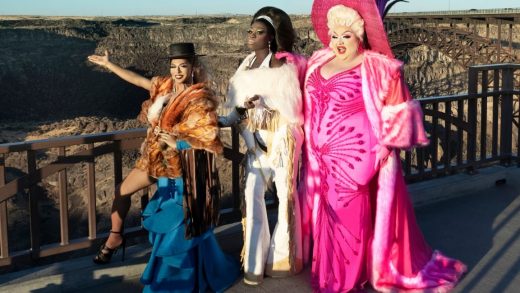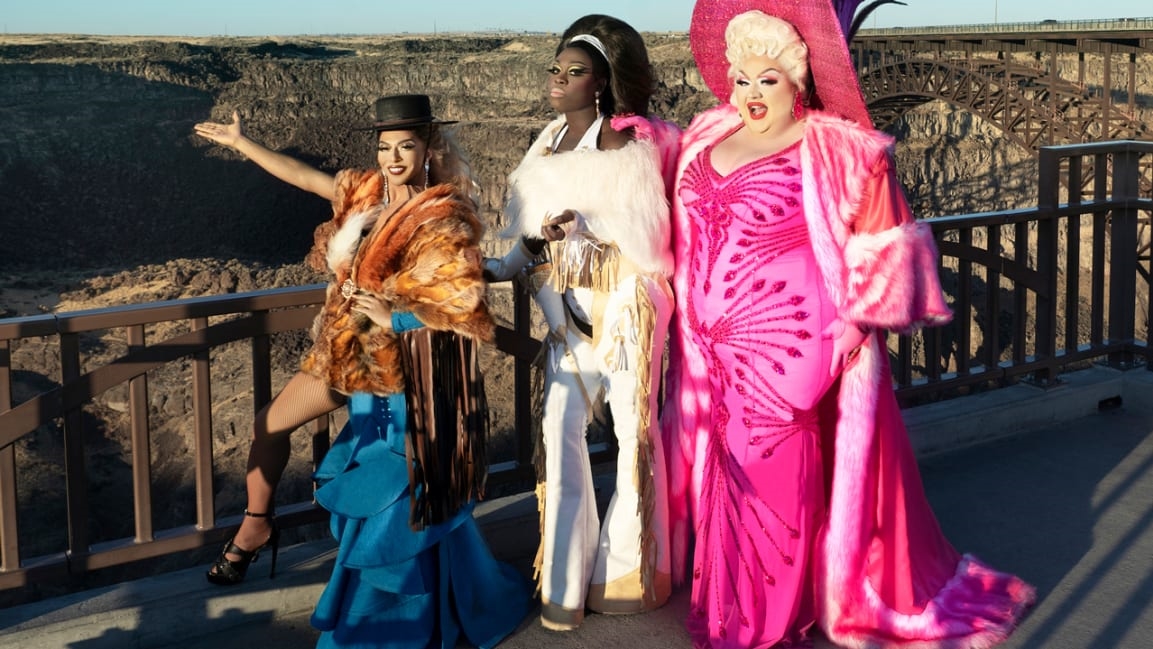HBO’s ‘We’re Here’ brings drag to small towns—and life-changing experiences to locals
The final touch in prepping for a drag performance, if not necessarily the pièce de résistance, is the tuck. It’s an anatomical concealment that, ironically, helps reveal these performers’ true selves.
On HBO’s We’re Here, it’s clear that a lot of small towns in America have their own municipal form of a tuck—and it works just the opposite way. These towns either ignore or obscure their queer populations, to prevent them from manifesting what’s just beneath the surface.
“A lot of the local LGBTQ communities are having to suppress some big conversations because it’s just not okay to be who you are where they are,” says Johnnie Ingram, We’re Here‘s cocreator. “This is happening in a lot of small towns. But when we bring a big, glamorous drag show through, it gets people talking about stuff that maybe hasn’t been talked about in a long time.”
The simplest way to describe We’re Here, which premieres on April 23, is that it’s a drag version of Queer Eye, the makeover show that brings tears to viewers’ eyes. There’s nothing simple about We’re Here, though. It isn’t quite like anything else. The show follows celebrity drag performers Shangela, Eureka O’Hara, and Bob the Drag Queen (stars of various seasons of RuPaul’s Drag Race) as they visit small towns in America and help some residents stage a one-time blowout drag show. Each of the six episodes takes place in a different town, with a different set of locals who all want to do drag for different reasons—aspiring performers, allies, and everything in between.
The show’s clever title cuts both ways, announcing to the towns that Shangela, Eureka, and Bob have just arrived, but also that the spirit of authenticity they thrive on is already there.
While the concept of drag has been around since at least the late 1800’s, when Europe’s pantomime dames first emerged, over the past decade, it has become a mainstream pop culture phenomenon. Boundary-pushing artists like Lady Gaga have long relied on drag queens to help design their looks and art-direct photo shoots, but only lately have those artists begun finding more outlets to shine in their own right. (For instance, when Lady Gaga personally handpicked Shangela for a role in A Star is Born.)
A lot of the credit for this revolution, of course, goes to a certain drag reality competition.
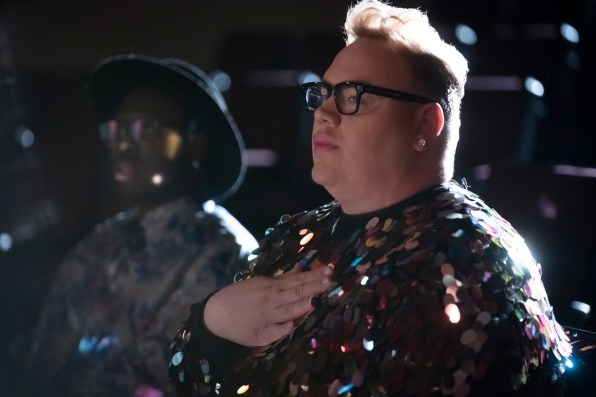
“Drag is definitely much more popular now than it was when I was a child, and I think that has a lot to do with RuPaul’s Drag Race and the success of that show,” says Bob the Drag Queen, who has become a beloved touring act since winning the show’s eighth season. “It also helps that all of these queens from RuPaul’s Drag Race have been out traveling into the world and working consistently.”
The focus of We’re Here is about the journey drag performers embark upon before ever coming to RuPaul’s attention.
“This is a bit more back to the roots of drag, which is this sort of small venue,” Ingram says. “We’re telling the stories of the people there and putting these towns on a stage for the whole community to see.”
Crowning their queens
Ingram and cocreator Stephen Warren come from different professional backgrounds (marketing for Ingram and entertainment law for Warren), but they both share a history of advocacy. It was Warren’s tenure as the cochair of GLAAD, the Gay and Lesbian Alliance Against Defamation, that made him aware of some LGBTQ issues he had previously not paid much mind.
Now he wants to give other people a similar awakening.
“I thought I already was a politically conscious person, but my eyes needed to open so much more, especially on issues of disadvantaged queer people,” Warren says. “I wanted to do something more, and I wanted to do it through drag, which is the perfect intersection of bringing fun to the world, while at the same time bringing queer culture and queer concerns to a bigger audience.”
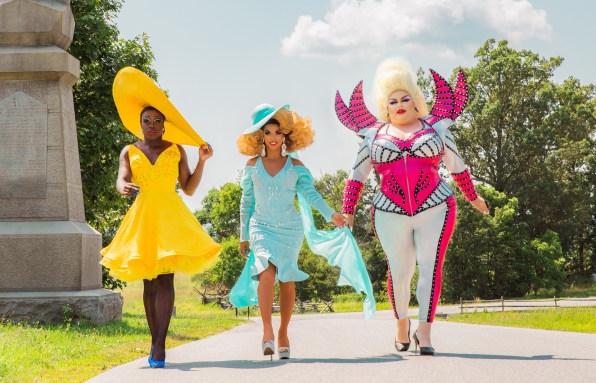
Ingram and Warren first conceived of We’re Here in late 2018. They soon met with the head of HBO’s unscripted division, who wanted in right away. Indeed, the network had already been looking for a concept in this vein. The creators assembled a team and shot the pilot late last summer; it earned them an official series order.
Shangela, Eureka, and Bob the Drag Queen—who were Ingram and Warren’s top, and only, picks for the show’s guides—were eager to be a part of the project. “When they assured me that we would be working with queer people and telling queer stories, that sealed the deal,” Bob the Drag Queen says.
Ingram and Warren knew the three drag queens (who happen to come from small towns themselves) were the perfect choice because they were performers with outsize empathy. For the show to work, the drag queens would have to connect with a wide variety of people in many different circumstances.
So much of the project centers around the three leads playing empathetic sounding boards as the participants describe their various struggles and motivations for appearing in a drag show. They then respond with insights gleaned from their own experiences—not so much as psychologists, but rather life coaches.
“We’re not trying to cure anybody,” says Eureka O’Hara. “We’re just trying to give these people a platform to discuss what is happening in their lives, but also show that there are resources and ways to come together even in these small, very persecuted towns.”
Finding poignant stories in unlikely places
Ingram and Warren worked with researchers to find just the right people and towns to feature in each episode. They would look for thriving drag scenes in an unlikely backdrop, or particular stories with resonance. They found a group of Mormon women in Twin Falls, Idaho, who call themselves the Mama Dragons and advocate for their own LGBTQ children. Members of this group helped the We’re Here crew track down locals whose lives might actually change for the better by participating in the show.
As much as it’s a cliché to say this of any piece of entertainment, the towns on this show are themselves characters. Many appear to be struggling with their own identities in some way, whether it’s a conservative Mormon population juxtaposed with the local queer community, or a historic town rooted in controversy, like Gettysburg, Pennsylvania. Watching each episode, viewers get a snapshot of the town’s personality and composition in the early scenes, when the drag queens pass out flyers promoting their one-night-only drag show; then they see a more detailed portrait later on, based on who from the town actually shows up.
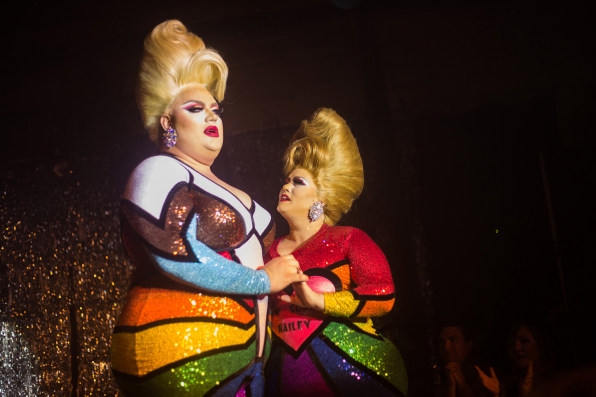
“The show’s goal is not to present these towns in a negative light,” Eureka says. “Of course, we showed a little bit of it, but we didn’t want to show, like, the moments in Branson, [Missouri], where people were driving by screaming hateful things at us from their car, or in Gettysburg, Pennsylvania, where there was a lot of discussion about the rebel flag. The show didn’t want to focus on just this negativity and nastiness.”
Editing helped keep the darker elements of the show in check. People from Branson sicced the police on the draq queens three times, for instance, but the show only features two such incidents. The emphasis is more on featuring the full range of reactions, from the folks making up weird excuses to avoid going to a drag show to the fans who recognize the leads from TV, to the more bigoted responses. Making it all work was no small feat.
“This is a huge collaboration,” Ingram says. “I mean, they say it takes a village to make a queen, but we’re bringing a village to make a village.”
The team the creators put together includes production designer Marla Weinhoff from Haus of Gaga, who wrangled the fabulous custom camper vans the queens bring to each town. (These vans were central to Ingram and Warren’s initial vision for the show.) Each queen was also able to bring along their own makeup artists and hair designers to help craft the looks for each performance, but as consulting producers, the onus was on them to design each performance with their new drag daughters, sons, or gender-fluid children.
“This was kind of like going through Drag Race, but for every episode,” Bob the Drag Queen says. “Like, imagine if I had to go do a season of drag race six times.”
First, the drag queens got a short dossier about their new wards, sometimes accompanied by a video clip of them talking about themselves. Then they actually would meet up and get to know each other.
Eureka, for instance, built an emotional performance around a mother’s deep regret over her initial intolerant response to her own daughter’s coming out. (Erica appears during the show in a lovely dress with “I’m Sorry, Hailey” emblazoned across the chest.) With Christopher, a heteronormative male who felt he was taught to hide his emotions, Eureka homed in on his obsession with wrestling as the centerpiece of his number, rather than risk giving Christopher whiplash by diving too quickly into Dolly Parton or Princess Di territory.
The resulting shows proved huge successes each time out. All kinds of people from each town would show up, either out of buzzy enthusiasm or pure curiosity. When there wasn’t enough space at a venue to accommodate all the people lined up to watch the show, the crew set up projection screens outside, where up to a thousand people would watch, united as a town.
“I feel like drag is an olive branch, regardless of what you believe,” Ingram says. “Whether you come for the spectacle, the town gossip, or you can relate, or you have a family member you want to support, everyone is often six degrees from the LGBTQ community.”
That’s where the third meaning of the title comes into play. We’re Here doesn’t just refer to the influx of celebrity queens, or the entrenched presence of aspiring ones; it also points to much of the rest of the town’s reaction to these shows and their performers. They’re here for them.
(6)

